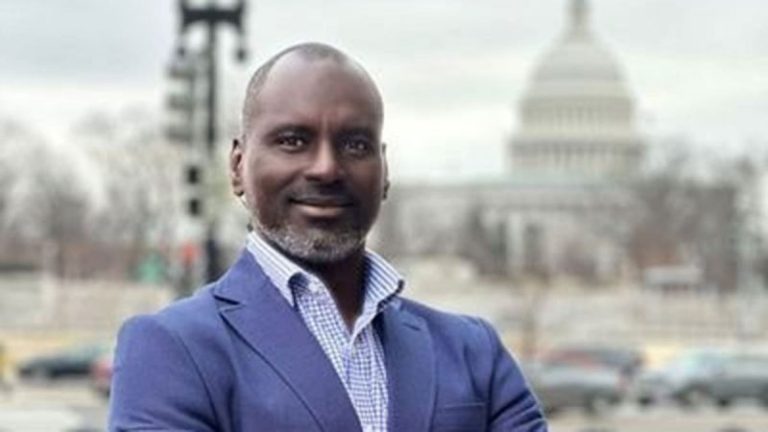When New York mayoral candidate Zohran Mamdani stepped to the microphone outside the Islamic Cultural Center of the Bronx last week near Yankee Stadium, his voice broke as he spoke about ‘the memory of my aunt who stopped taking the subway after Sept. 11 because she did not feel safe.’
Behind him, a Yemeni-American educator in sunglasses named Debbie Almontaser nodded. Almost two decades ago, in 2007, she was forced to resign as principal of a city school after defending a T-shirt with the slogan ‘Intifada NYC.’ City officials viewed it as a call to violence. She said it was benign. Her case became a rallying cry for Muslim American activists who cast her as a victim of ‘Islamophobia.’
Now, Almontaser was back, this time as a senior advisor to Emgage Action and a board member of Yemeni American Merchants Association Action, two of 110 political nonprofits, community groups and political action committees backing Mamdani as he alleges ‘islamophobia’ against him. Recently, when critics questioned Mamdani’s ties to hardline Brooklyn Imam Siraj Wahhaj, she sprang to action, helping to organize a protest to defend Wahhaj.
That rapid, coordinated response captured the modus operandi of a network of political operatives and clerics intertwined with the shared mission of catapulting Mamdani into the mayor’s office.
Mamdani’s background diverges from many of his co-religionists. In an interview, he said he is a Khoja Shia Muslim, part of a small, relatively liberal sect with roots in India. Many of his New York-area allies are religiously strict Sunni Muslims who practice more conservative interpretations of the faith. But they find common ground in politics.
‘It’s a sophisticated fusion of religion, politics and identity,’ said Mansour Al-Hadj, a Washington-based researcher on Muslim political movements and extremism. ‘The same networks that once focused on community services are now mobilizing voters and producing candidates. This is how political Islam adapts inside democracy.’
Mamdani’s God Squad includes about a few dozen key players who specialize in painting any critique as an attack on their faith, accusing critics of Islamophobia even as many of them have engaged in strident rhetoric against the U.S., Israel and capitalism.
Mamdani set off a firestorm on Oct. 7 when he walked into Masjid At-Taqwa in Brooklyn and later posted a photo of himself beaming beside the mosque’s imam, or prayer leader, Siraj Wahhaj.
The imam’s checkered past goes back decades. In a 1992 talk, he said American Muslims should elect an ’emir’ rather than choose between George Bush and Bill Clinton. Soon after, he served as a character witness in the trial of Sheikh Omar Abdel-Rahman, the so-called ‘Blind Sheikh’ convicted for plotting the 1993 World Trade Center bombing that killed six people.
‘You know what this country is?’ Wahhaj said in 1995. ‘It’s a garbage can. Filthy. Filthy and sick.’
In 2018, three of Wahhaj’s children were arrested after authorities found 11 malnourished children in a New Mexico compound tied to his family; a grandchild had died in what authorities described as an attempted exorcism. He told local news reporters, ‘Whatever they did wrong…it’s not acceptable to us.’
In New York, the Muslim American Society recently signed onto a letter to challenge ‘unmistakably Islamophobic, anti-Black, and xenophobic’ attacks on Mamdani. Signatories included CAIR National, the Council on American-Islamic Relations’ New York chapter, Islamic Circle of North America’s New York chapter, the Islamic Center of Five Towns, Muslim American Society of New York, Muslim Community Network, Rockaway Islamic Center, and a ‘Syosset Muslim Community.’
Members of the Muslim American Society have long been quick to accuse others of Islamophobia even as they unabashedly call for violence against their perceived enemies.
At an Eid celebration earlier this year, a cleric at the Muslim American Society, cast Muslims as victims worldwide. Mohammad Badawi, youth director at the Muslim American Society, declared the local community’s joy would only be complete when Muslims are ‘victorious worldwide,’ adding they would celebrate ‘after the destruction of the illegitimate Zionist occupiers,’ Israel.
He regularly organizes anti-Israel protests in a campaign against ‘injustice and oppression.’ At one protest, Badawi urged youth to ‘fight back’ against injustices ‘by any means necessary.’
The Street Protester: ‘Globalize the intifada’
Abdullah Akl, a charismatic organizer with the Muslim American Society Youth Center, leads many protests under the banner of ‘Within Our Lifetime,’ with founder Nerdeen Kiswani. Mamdani joined them before his run for mayor.
Akl calls the street protests ‘sacred activism,’ a mix of faith and resistance that will ‘free Palestine.’ Since the Oct. 7, 2023, Hamas attack on Israel, the Muslim American Society Youth Center has organized prayer protests on Wall Street outside the New York Stock Exchange, street protests for ‘Nakba Day,’ calling the day Israel was created a ‘catastrophe’ and youth-led demonstrations outside BlackRock.
Akl turned a subway car into a protest zone with chants: ‘Globalize the intifada… There is only one solution: intifada revolution.’
When the New York Police Department arrested Akl and other activists, the Council on American-Islamic Relation’s New York chapter sent out a press release demanding their release.
On Oct. 7 protests this year against Israel, Akl shouted, ‘We did not act enough! We will show up, stronger than we did the first October 7th!’ In response to criticism, he posted a message on social media, doubling down and saying, ‘Saying we didn’t act enough to stop a full blown genocide against palestinians [sic] is incitement?? Saying we need to be louder and protest more and continue to speak up for gaza [sic] is a crime? Zionist tears once again for the most documented genocide in modern history.’
CAIR: ‘We will teach these folks a lesson’
For decades, Council on American-Islamic Relations (CAIR) has served as an aggressive and litigious watchdog for a host of Muslim figures and causes, often at the forefront of fighting legitimate bigotry. But CAIR has also courted controversy. Federal prosecutors named CAIR an unindicted co-conspirator in a federal terrorism-financing case against the Holy Land Foundation, a nonprofit based in Texas. In 2008, five Holy Land leaders were convicted of funneling $12.4 million to Hamas. Ultimately, no CAIR officials were charged in connection with the case.
Years ago, Mamdani recorded rap lyrics celebrating the ‘Holy Land Five,’ urging listeners, ‘My love to the Holy Land Five. You better look ‘em up.’
Basim Elkarra, executive director of the Council on American-Islamic Relations California chapter and one of the founders of a new 501(c)(4) nonprofit, CAIR Action Inc. now seems to be pursuing a new and entirely legal means of financing causes, taking a page from the powerful pro-Israel political action committee AIPAC. He told a meeting of the Islamic Circle of North America: ‘AIPAC has had the run for 60 years, but it is over now.’
‘We will teach these folks a lesson … we are coming.’
‘…The game has changed. AIPAC has been around since 1961…and now they have a formidable foe!’
The Former Al-Jazeera Host: ‘Make American Planes Crash Again’
This summer, Mehdi Hasan, a former host at Qatar’s Al Jazeera TV network, sat down with Mamdani for a sympathetic interview. As the campaign heated up, Hasan became a full-time defender on social media, swatting at critics and framing Mamdani as the right kind of provocateur, a ‘once in a generation political talent.’
Hasan’s own record includes sermons likening non-Muslims to ‘animals’ and comparing gay people to ‘sexual deviants.’ He has said his views have become more progressive since then.
After a series of plane crashes earlier this year, Hasan wrote on social media, ‘Make American Planes Crash Again.’
He deleted the message amid criticism and said, ‘I deleted this sarcastic quote-tweet because MAGA and Islamophobic folks are clipping it out of context and trying to ridiculously suggest I’m inciting violence. I was obviously mocking the MAGA slogan ‘Make America… Again’ slogan and highlighting the shocking number of plane crashes under Trump and the FAA cuts. But this tweet was in poor taste, poorly worded, and has allowed people in bad faith to call me a terrorist…’
The Global Imam: Read ‘The Hoax of the Holocaust’
Yasir Qadhi, a high-profile American imam and founder of the AlMaghrib Institute and MuslimMatters.com, selling the puritanical Salafi interpretation of Islam, literally wrote the book on ‘Understanding Salafism.’ Recently, he posted a two-part thread on X endorsing the idea of Mamdani’s win as a ‘civilizational victory.’
He urged Muslim Americans to move beyond ‘naive’ religious critiques of politicians who are more socially progressive than they are comfortable.
Meanwhile, Qadhi once mocked European Jews as ‘white, crooked nose, blonde hairs’ and ‘not a Semitic people.’ In the same lecture, he recommended a book, ‘The Hoax of the Holocaust.’
Most recently, he has backed the controversial Muslim housing development outside Dallas, called ‘EPIC City.’ He noted in his Instagram post: ‘open to non-Americans as well.’
He touted some of its features: ‘Islamic schools, college, masjid.’
The Popular Chaplain: Build ‘Our Own Space’
Imam Khalid Latif is a popular chaplain at the Islamic Center of New York City, a $22 million project to build a hub and ‘our own space’ on Sixth Avenue for young Muslim professionals. He endorsed Mamdani earlier this year and has been an ardent supporter. He has called him ‘a bearer of compassion in a time where it is far too rare.’
In 2012, Latif led a pilgrimage to Saudi Arabia that included Omar Mateen, who would later murder 49 people at the Pulse nightclub in Orlando, the deadliest anti-LGBTQ attack in U.S. history. He has denied radicalizing Mateen and he hasn’t faced the same type of allegations that surround other imams.
After the backlash to Mamdani’s meeting with Wahhaj, he posted: ‘Happy birthday to my brother Zohran… Keep showing them who we are by showing them who you are.’
He invoked the divine to bless Mamdani’s mission, revealing the fusion of religion and politics for the Mamdani God Squad: ‘May your 34th year be one of clarity, courage, and closeness — to your purpose, your people, and your Creator,’ ending with the Arabic word for amen, ‘Ameen.’
On Monday, Latif posted a sassy video from the Muslim Democratic Club of New York with a narration, ‘The name is Mamdani, M-a-m-d-a-n-i,’ with Latif mouthing the part where the narration turns to, ‘You should learn how to say it.’
That day, Latif delivered a speech to support Mamdani, pivoting to allege Mamdani was now a victim of ‘anti-Black racism,’ saying, ‘Anti-Muslim sentiment is always’ a symbol of ‘anti-Black racism.’
The ‘Home Girl in a Hijab’ from Brooklyn: ‘I wish I could take their vagina away’
In a glowing portrait, The New York Times called Palestinian American political organizer Linda Sarsour a ‘Brooklyn home girl in a hijab.’ Over almost a decade, she has been a political mentor to Mamdani, inviting him into the Muslim Democratic Club of New York, which she cofounded. She later endorsed his race for the New York General Assembly, which he won.
All the while, she has been a polarizing figure, once saying about two critics, author and ex-Muslim Ayaan Hirsi Ali and activist Brigitte Gabriel, ‘I wish I could take their vagina away – they don’t deserve to be women.’ Ali is a survivor of female genital mutilation, a practice that involves cutting the clitoris of a young girl with the idea that it will inhibit sexual promiscuity.
As a co-founder of the Women’s March, Sarsour stepped down amid criticism for alleged ant-semitism and not welcoming Jewish feminists who support the state of Israel, or ‘Zionists.’
At a rally on Sunday night with Sen. Bernie Sanders and Rep. Alexandria Ocasio-Cortez, Imam Latif told 13,000 people: ‘This is our city. This is our moment.’
Some Muslims beg to differ.
‘It’s not our moment,’ said Al-Hadj.
‘Across the boroughs, the Mamdani God Squad is banging a drumbeat of grievance after grievance, from Staten Island to Brooklyn, Manhattan, Queens and Long Island,’ he said. ‘Across the city’s Muslim institutions, you hear the same drumbeat: They smeared us. They silenced us. They fear us.’.
He added, ‘In that rising volume, something is lost: Muslim pluralism. The God Squad does not speak for every Muslim in New York—nor for every Shia, every Sunni, every immigrant family, or every second-generation kid trying to thread faith and freedom. It speaks for a coalition committed to illiberal ends, with socialist capture of city politics on the one hand and puritanical religious rhetoric on the other. They insist that to oppose them is to betray the community, so they actually push their own tyranny.’
Win or lose next week, Al-Hadj said, the Mamdani God Squad had actualized the words that had gotten Almontaser into so much trouble years ago: ‘Intifada NYC.’
This post appeared first on FOX NEWS










